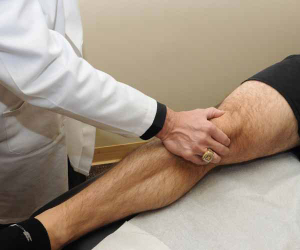In most cases with patellar dislocations, the patellar dislocates laterally. This results in stretching of the medial tissues and can result in continued instability, especially in patients who have trochlear dysplasia. While most patients with first time patellar dislocations should undergo a nonoperative treatment program, patients who have recurring patellar instability should consider a surgical reconstruction to prevent recurrent instability in the future.
The best test to determine whether a patient is having symptoms from a subluxing or dislocating patella, is the lateral patellar apprehension test. It is performed with the knee flexed to 45° over the side of the examining table. One hand will stabilize the leg while the other applies a lateral translation force to the patella. It is especially important during this test to have the patient relax. For some patients who have normal joint laxity and if they do not feel as if the patella is going to dislocate, increased lateral subluxation may be normal for them. In this case, one should assess the contralateral normal knee to verify their exam. In patients who feel like the patella is going to redislocate especially when it reproduces their symptoms, one should be concerned that their symptoms are due to recurrent patellar subluxation or dislocation.

